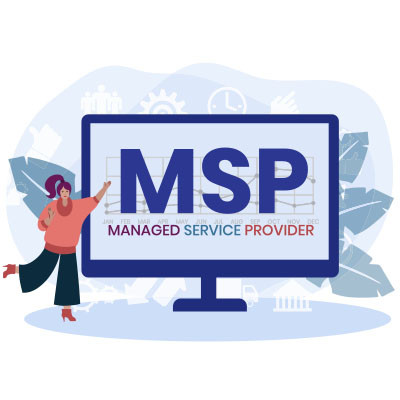Professional services make up a significant portion of the business landscape. They can be broadly defined as any organization with trained professionals at the center offering a service of note. The most common professionals under this umbrella term are lawyers, agents, consultants, and others who help businesses in their day-to-day operations. Let’s explore some of the technology that fuels professional service providers.
EZ MSP Blog
Technology has ingrained itself into just about every facet of modern life, particularly in the business world where every competitive edge makes a difference. Many small and medium-sized businesses simply don’t have the staff on-hand to manage and maintain their technology solutions, instead opting to outsource this important responsibility to managed service providers (MSPs).
For any business to succeed, it needs to exhibit some degree of empathy toward its audience. Otherwise, the services and products they offer will be less likely to meet the priorities and needs that its targets are experiencing.
As a managed service provider, this is perhaps most true of us, as our services revolve around predicting the needs of our clientele and resolving them… ideally, before the client even realizes they have a need to fulfill.
SMBs need to be able to navigate the complexities of IT, whether it’s with a completely outsourced IT department or an in-house team of technicians. However, if you are thinking of technology management in this black-and-white way, you are eliminating the potential for enormous benefit through the use of co-managed IT.
Cost/Benefit is a term you hear a lot. It’s always used in conversations about potential investment and means something. Well, at least it should. One of the places that many people can gain benefits from their investments is by outsourcing some of their responsibilities to an outside vendor. This works especially well with IT management. Let’s take a look at why outsourcing your technology support and management is a good investment.
Business technology is a useful tool, there’s no way around it. Unfortunately for businesses, technology has to be replaced every so often. Even if the technology doesn’t break, there are innovations made that can help your organization do what you do better. The thing is: Technology does break, so you need to understand how to get the most value out of it when it is working.
The information technology solutions that are out there for businesses to utilize are constantly improving. While these improvements are beneficial to your operational abilities, you do need to make sure you are staying up to date. This is where a managed service provider can help. Here, in the final part of our series exploring the value of managed services, we’re considering procurement assistance.
Why do we focus so strongly on business productivity? In many cases, it can be boiled down to a basic equation: the more productive a business is, the greater the value that its actions will have. This is just one way that managed services can bring a business value - by helping to make its actions more productive. That’s why it is only fitting that we look at productivity in this first installment of our series examining the added value that managed services provide.
The business that manufactures products is first and foremost interested in efficiency. They need their processes to turn out product, be cost effective, and be repeatable. The aim of IT services for manufacturers is to help facilitate efficient and effective processes starting with procurement of resources through to the support of the goods.
In business today outsourcing your IT management or project management is routine. It wasn’t always so. For the first couple of decades of IT for business, that was the only way you were going to get a piece of technology up and working again without massive capital investment. Today, we will take a look at the break/fix method to IT management and how it is far more expensive than you may think.
Chances are that if you are a business owner that has been in business for a decade you’ve seen how emerging technologies have changed the face of business. Technologies like cloud computing have opened up opportunities for many businesses to get the powerful computing infrastructures they need without massive upfront costs. As this trend continues, the IT services has begun to move past core IT management and support and onto providing real solutions for the modern business. Today, we will look at how the Managed Service Provider (MSP) is at the forefront of a data revolution that has no end in sight.
Let’s say that your organization has experienced considerable growth over the past couple of years. It’s not outpacing your IT infrastructure, and the cracks are starting to show in more ways than one. This makes it difficult to plan for the future, implement new IT initiatives, and react to issues as they crop up. If your business doesn’t have an internal IT department heading these developments, outsourcing can be a viable option to make sure all of your organization’s technological needs keep your progress moving forward.
Uh oh - your critical business systems are acting up again, and you aren’t sure what’s causing the problem. Fortunately, you aren’t caught up in this alone. There are those that can help you, just like a doctor would if you were ill. However, instead of calling your healthcare provider, you want to call a managed services provider.
Chances are, you most likely view your vendors as a necessary evil. While you have to work with them to get the things that your business needs to function, it’s hard to not think of everything else that could be accomplished in the time you spend dealing with them. Unfortunately, there are even more costs to dealing with vendors that you may not have considered.
Project implementation is a tricky subject for small businesses to approach primarily due to a lack of funding or dedicated personnel. Nowhere is this more true than for technology project implementation, be it a new email server or a revamped networking infrastructure. Depending on your business’ specific situation, it’s often more convenient to simply invest in outsourcing the project management to a third party.
How does your business manage its technology solutions? If you have an in-house IT department, you might think that you have a better shot at keeping your business safe from a hard drive failure, but this is only if your IT department isn’t already overwhelmed with work. You might find that implementing new solutions is tricky, which wastes time and resources on your part. What’s the small business to do?
How does your organization manage its mission-critical technology solutions? We know that most small businesses have some sort of trouble with this topic, either due to budget constraints or a lack of personnel. Either way, we know that there is a better way to manage your business’ technology, and it’s all thanks to managed IT services.
You might have only recently heard about outsourced IT services, but you might be surprised to hear that they have been around for far longer than you previously thought. Even before managed IT, however, business owners and individuals alike were using the outsourced services of others to simplify operations and day-to-day tasks related to their technology management.




















